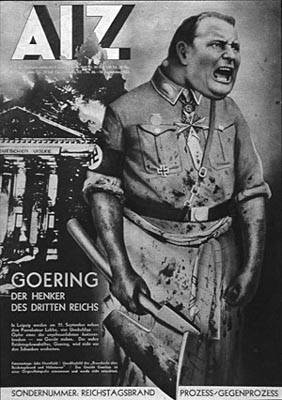
: Oh Tannenbaum! O Tannenbaum

Helmut Herzfeld (1891-1968) was a German artist strongly critical of the Weimar Republic and Nazi Germany. Born in Berlin in 1891, the political art of John Heartfield was banned throughout Hitler's Third Reich.
Heartfield developed the new medium of photomontage and made it a new art form and a means for social protest and propaganda. In 1912, Herzfeld worked as a designer before he moved to Berlin to study at the Arts and Crafts School. He was drafted into the army where he met George Grosz, who becomes his life long friend and collaborator
In 1916, Herzfeld anglicizes his name to John Heartfeld in protest against the anti-British hate campaign and World War 1. In the early months of World War 1, the kaiserand his militarist succeeded in persuading patriotic Germans to greet each other on the street with "God Punish England." This prompted the young painter and graphic designer Helmut Herzfeld to change his name forthwith to John Heartfield. Although the name was refused legalization," the name proved to outlast the Kaiser's empire", wrote Wieland Herzfelde, the artist's brother and life-long collaborator.

1916, Heartfield and his close friend Georg Grosz
discover the new technique of photo montage. It is not clear if it was only Heartfield who made the discovery and that Grosz took too much credit, none the less, photomontage remained an integral to Heartfield's work. The original use of photomontage came from the soldiers on the Western Front, who could not get their reports past the censors, developed an ingenious technique of pasting cutouts from illustrated papers and photographs to tell their stories visually of the horrors experienced, to family back home.
Heartfield's art would become more politically aggressive as Germany suffered from depression, inflation, and the the threat of Fascism. In 1928 he created The Face of Fascism, a montage depicting a skull-like face of Mussolini, surrounded by corrupt backers and his dead victims. The montage spread all over Europe with a unstoppable and powerful force.
At the same time, the Dadaists were using the technique of photomontage. The Berlin Dada group consisted of Heartfield, Herzfelde, Grosz, Hausmann, Huelsenbeck, Hoch, Mehring and Baader, all of whom were part of the revolutionary struggle in postwar Germany. The poster Der Dada, is one of Heartfield's earliest photomontages, #3 Cover, 1920. The image with it's chaotic juxtopositioning, represents a turbulent state after the First World War.

The
were anti-war and anti-establishment, and since 'art' was a part of the corrupt bourgeois society, they were also 'anti-art' rejecting all bourgeois's art forms. Many believed that the reason and logic of bourgeois capitalist society had led people to war. Dada influenced future styles in art, photography, theatre, and music.


Heartfield also believed that photography was going to be the forefront of a new art that would displace painting. With photographic tricks and painting Heartfield arranged parts of a photo to fit together seamlessly. With extraordinary care he created images that went straight to the printer. With the highly sensitive copperplate photogravure method, mistakes could be clearly evident.
Heartfield also designed photo-based symbols of images such as clenched fists, and raised arms depicting strength, action, and determination. The image below of a clenched fist was used to replicated a radio antenna for a Communist-affiliated radio station in Czechoslovakia that broadcasted into Germany during the war. Heartfield's symbols helped to compete with the Nazis' swastika.

HEARTFIELD'S POSTER: THE VOICE OF FREEDOM IN THE GERMAN NIGHT ON RADIO WAVE 29.8, 1937.

The Malik Verlag, a press run by Heartfield's brother, Wieland Herzfelde, ran exclusively to enable leftist books on social issues be distributed to the German public. The dust cover's were an important eye catching device used by John Heartfield to attract attention to these books. Below 'Der Sumpf', (The Jungle, Upton Sinclair) was created in 1928 by Heartfeld.

In 1917, Heartfield, his brother, and George Grosz published an avant-garde periodical called the Neue Jugend (New Youth) and created unique typographic ideas by taking old engravings and various type, combining them in an unrestrained and random stream of consciousness.
This technique would be practiced at the Bauhaus and the Art Nouveau artists of the Jugendstil movement, as well as the Russian constructionists, who used the experimental typography in their work. Koloman Moser poster for the 13th Vienna Secession exhibition incorporating new ideas to be adopted by commercial artists from that point forward, influencing modern design through out history and today.
George Lois Esquire covers 1968

'The President Speaks', Grosz.
The Neue Jugend was banned in 1916. A year later, Heartfield cleverly outwitted the censors by making the journal a advertisement for George Grosz's portfolio of artwork. During the twenties, Heartfield designed book jackets using both typography and photomontage elements for the left wing Berlin publishing house called the 'Malik Verlag. In the late 20's when the newspaper, Illustriete-Zeitung (Worker's Illustrated Paper) was being printed on copperplate, did Heartfield find a way to circulate his political montages to the masses. Heartfield's pieces in the AIZ
(The Worker's Illustrated Paper) had a circulation of half a million, people eagerly waiting for Heartfield's latest argument. Today these works are picture documents illustrating the struggle between Fascism and democracy, capitalism and socialism, war and peace.
References:
-www.getty.edu/art/exhibitions/heartfield/
-Neue Jugend: wikipedia
-http://homepage.ntlworld.com/davepalmer/cutandpast/heartfield.html
-www.kettererkunst.com/bio/john-heartfield-1891.shtml
-http://www.bbc.co.uk/history/historic_figures/wilhelm_kaiser_ii.shtml
-http://www.sas.upenn.edu/~jenglish/English104/tzara.html
-http://www.spartacus.schoolnet.co.uk/FWWheartfield.htm
`http://en.wikipedia.org/wiki/George_Grosz
-http://en.wikipedia.org/wiki/Dadda#Berlin
-UTube
-Google Images